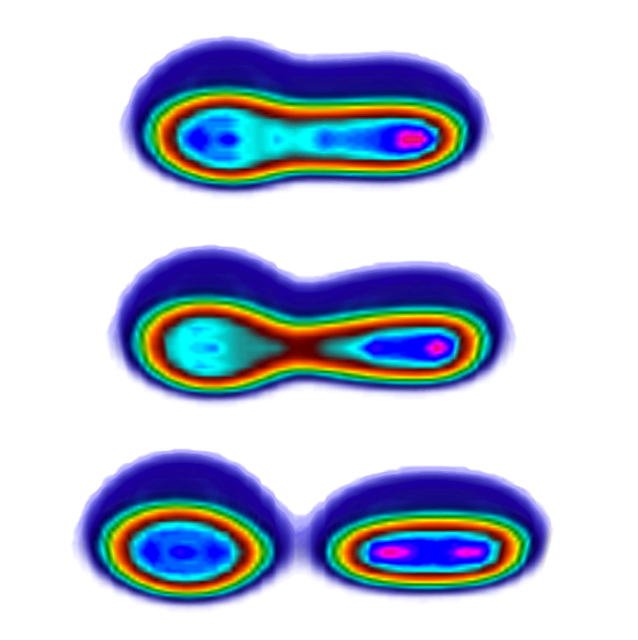Ind uced
Fission of Pu240 within a Real-Time Microscopic Framework
uced
Fission of Pu240 within a Real-Time Microscopic Framework
Time-Dependent Superfluid Local Density Approximation
Phys.
Rev. Lett. 116, 122504 (2016), DOI,
pdf

Talks:
A. Bulgac, Tokyo, October
2015 (pdf,
no videos)and with videos
pptx
ECT*, Trento, Italy, June 8, 2016, pdf (17.9 MB, no videos) with
videos pptx (255.8 MB)
INPC 2016, Adelaide, September 11-16, 2016, pptx(163.1 MB)
Fussion17, Hobart, Tasmania, 20-24 February, 2017, pptx
ECT*, Trento, Italy, March 20-25, 2017, pptx
P. Magierski, GANIL, October 2015
(pdf,
no videos)
I. Stetcu, FUSTIPEN, March
2016, pdf (no
videos) or pptx
If your default video player does not work, you can try VLC, which
works for many video formats and several OS.
QuickTime
will likely work well.
Videos:
Warning! Apparently the latest
version of Firefox on macs with El Capitan has problems with
opening the videos. The culprit appears to be Apple, who
disabled the QuickTime plugin. In the Library/Internet
Plug-Ins/Disabled Plug-Ins copy the two files in there and
put them in the Internet Plug-Ins folder and restart Firefox
and reactivate QuickTime at the prompt. Or, use another
browser. I have tried Chrome, Safari, and SeaMonkey and they
work.
A system of bearing balls rolling down,
with and without obstacles. The obstacles simulate the presence
of additional transversal degrees of freedom, which even though
do not modify the value of the potential energy or of the mass,
thus do not affect the speed, but change the length of the
trajectory and thus of the time to reach destination. This is a
simple realization of the Drude model for electron conduction.
Time
evolution of the proton and neutron densities in S1-S3
Time
evolution of the spatial amplitudes of the proton and neutron
pairing field in S1-S3
Time evolution of the spatial amplitudes of the proton and
neutron pairing fields in S1-S3 (slow)
Time
evolution of the densities in S2 and S3
Time
evolution of the densities in S2 and S3 (slow)
Time
evolution of the pairing fields in S2 and S3
Time
evolution of the pairing fields in S2 and S3 (slow)
Time
evolution in S1
Time
evolution in S1 (slow)
Time
evolution in S2
Time
evolution in S2 (slow)
Time
evolution in S3
Time
evolution in S4
Time
evolution with currents S3
Time
evolution with currents (slow) S3
Time
evolution with currents (log scale) S3
Time
evolution with currents (slow, log scale) S3
 uced
Fission of Pu240 within a Real-Time Microscopic Framework
uced
Fission of Pu240 within a Real-Time Microscopic Framework